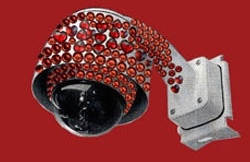The surveillance cameras throughout the streets of Amsterdam looked really boring to Jill Magid, a conceptual artist.
So for her next street-art project, Jill wanted to decorate those dull cameras with rhinestones. But when she presented her plan to city officials, they just scratched their heads and told her they didn’t work with artists.
But Jill didn’t give up. A few weeks later, she returned to city hall, this time presenting herself as a Security Ornamentation Professional at System Azure, a made-up company.
She gave her carefully crafted pitch. And when she was done, the administrators agreed to let her bedazzle their cameras. Matter of fact, they even paid her a couple of thousand dollars to do it, according to The New Yorker.
I don’t tell Jill Magid’s entertaining story to advocate her tricky tactics — such deception is usually a sure recipe for sudden ruin.
I pass along the episode because of what she had to say afterwards.
“I realized that the officials could not hear me when I spoke as an artist,” Jill said
Wow. Highlight that comment because it holds a lesson for all of us who present ideas to decision makers.
“I realized that the officials could not hear me
when I spoke as an artist.”
To connect with decision makers, we must present ideas in their language — not in the language of design, marketing, branding, meeting planning, public relations, product development or whatever your calling.
To be heard, we must be sure we aren’t talking to ourselves with the terminology and examples in our presentations, but rather embracing the culture and vernacular of decision makers.
We need to know their business and talk their language.
Otherwise, they can’t hear us when we speak.
 zingzone
zingzone